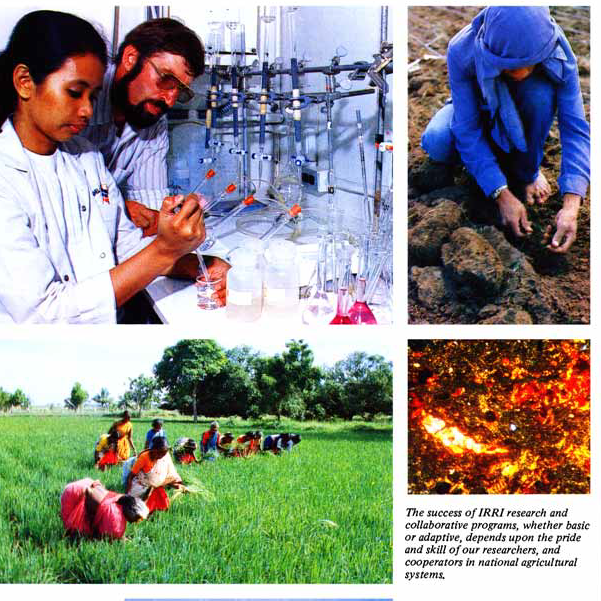In 1984, as we approach our 25th anniversary, it is important that we evaluate past achievements and look forward to the new directions the current global agricultural situation demands. When we began, our efforts concentrated upon improving yields and production in the irrigated lowlands of South and Southeast Asia. Through collaborative work with national research systems, short-statured, fertilizer-responsive, pest-resistant varieties were developed, introduced, and widely adopted. The real price of rice to consumers fell and some rice-importing nations became exporters. Confidence in rice research increased, and through training and collaborative research, we helped establish a secure foundation for continued improvement of rice production and management. .
.
In 1984, as we approach our 25th anniversary, it is important that we evaluate past achievements and look forward to the new directions the current global agricultural situation demands.
 When we began, our efforts concentrated upon improving yields and production in the irrigated lowlands of South and Southeast Asia. Through collaborative work with national research systems, short-statured, fertilizer-responsive, pest-resistant varieties were developed, introduced, and widely adopted. The real price of rice to consumers fell and some rice-importing nations became exporters. Confidence in rice research increased, and through training and collaborative research, we helped establish a secure foundation for continued improvement of rice production and management.
When we began, our efforts concentrated upon improving yields and production in the irrigated lowlands of South and Southeast Asia. Through collaborative work with national research systems, short-statured, fertilizer-responsive, pest-resistant varieties were developed, introduced, and widely adopted. The real price of rice to consumers fell and some rice-importing nations became exporters. Confidence in rice research increased, and through training and collaborative research, we helped establish a secure foundation for continued improvement of rice production and management.
Our first and most important challenge in the coming years is to defend the gains already made. Although many modern rices have resistance to insects and diseases such as brown planthopper, stem borer, tungro, and bacterial blight, pests continue to evolve and change. Our entomologists, pathologists, and breeders must monitor insect biotype development and disease virulence patterns to keep in the development pipeline new breeding lines with a wide spectrum of resistance genes for the time when a new pest causes economic losses.
In 1984, we carefully watched planthopper evolution in Indonesian and Philippine fields and observed changes in green leafhopper populations. Virulence patterns of bacterial blight in some countries are substantially different from 5 years ago. Research on tungro, with the help of an electron microscope, has identified differently shaped virus particles and particle combinations and related them to disease intensity.
Rices with wider genetic sources of pest resistance and more tolerance to soil and environmental stresses will remain essential to stable and increased yields. Expanding the rice germplasm collection, including the wild rice collection, will broaden the pool from which genes for resistance may be extracted.
Soil stresses such as salinity, aluminum, and iron toxicity, and phosphorus-deficiency limit yield or prevent useful cropping on large land areas around the world. Rice, often used as a reclamation crop in poor soils, has shown substantial potential for tolerating adverse soils. Soil chemical and soil physical research are essential to understand tolerance mechanisms and growth patterns that will help researchers develop varieties for areas where rices cannot now survive.
The development and use of low-cost technologies such as organic manuring and cultural methods to encourage the growth and multiplication of nitrogen-fixing organisms are receiving increasing attention. These will complement the use of inorganic fertilizers to increase soil nutrients and reduce investments in purchased inputs. To improve the efficiency with which fertilizers maintain and increase yields, we must optimize water management to decrease nitrogen volatilization and encourage the use of fertilizer deep-placement and injection machines, and correct timing of applications.
For those countries that have reached self-sufficiency in rice, research into the nutritional value of the rice grain and consumer grain quality preferences is increasingly important. In 1984, we conducted preliminary marketing surveys to identify rice types that consumers prefer and worked with researchers in the United Kingdom and Denmark to quantify the nutritional value of rice varieties and the effects of milling on different types of rice grains.
As we work to defend those gains already achieved for favorable rice-growing areas, we also must intensify our efforts to find better-adapted varieties and management methods for adverse environments and give greater attention to social and equity issues.
We are continuing our efforts to more precisely classify world rice environments. Terminology for rice growing environments, published in 1984, is the first step in developing a universal language for rice cultural types and environments around the world. More than 50 rice workers contributed time and ideas to the booklet. We will continue to incorporate additional data and work to fine-tune the terminology.
Breeding and management for adverse environments, in which more than half of the world’s farmers must survive, are challenging problems to address. In most harsh environments, farms are small, management practices may degrade what are already poor soils, and the economy and market infrastructure are underdeveloped. We are working to develop drought- and submergence-tolerant varieties; simple, low-cost input management practices, and simple machines that will increase yields and cropping intensity while reducing human drudgery.
In these environments, homegrown inputs such as nitrogen-fixing green manure crops and ecologically advantageous cropping patterns may be especially important. Cropping systems projects in disadvantaged areas are answering questions about modern technology adoption and its consequences for farmers, families, and laborers, and are establishing a basis for extrapolating new technology to other impoverished areas.
Similarly, we need studies to identify the effect of modernization on the availability of work traditionally performed by women and other landless laborers. Technologies for increasing the income of women farmers and laborers will receive attention under the Asian Rice Farming Systems Network. Research to understand market infrastructure also will contribute to the introduction of better farming methods.





